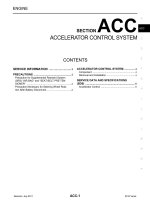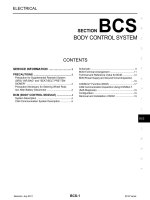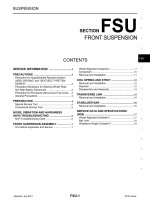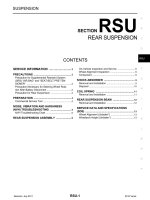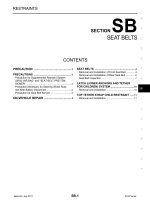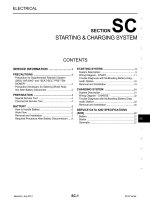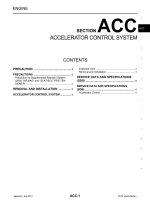HA hệ THỐNG điều hòa, sưởi TRÊN NISSAN VERSA SEDAN 2012
Bạn đang xem bản rút gọn của tài liệu. Xem và tải ngay bản đầy đủ của tài liệu tại đây (1.94 MB, 40 trang )
HA-1
VENTILATION, HEATER & AIR CONDITIONER
C
D
E
F
G
H
J
K
L
M
SECTION HA
A
B
HA
N
O
P
CONTENTS
HEATER & AIR CONDITIONING SYSTEM
PRECAUTION 3
PRECAUTIONS 3
Precaution for Supplemental Restraint System
(SRS) "AIR BAG" and "SEAT BELT PRE-TEN-
SIONER"
3
Precaution for Work 3
Precaution for Refrigerant Connection 3
Precautions For Refrigerant System Service 5
Service Equipment 7
PREPARATION 9
PREPARATION 9
Special Service Tool 9
HFC-134a (R-134a) Service Tool and Equipment 9
Commercial Service Tool 11
SYSTEM DESCRIPTION 12
COMPONENT PARTS 12
Component Parts Location 12
Component Description 12
SYSTEM 13
System Diagram 13
System Description 13
BASIC INSPECTION 14
DIAGNOSIS AND REPAIR WORKFLOW 14
Workflow 14
REFRIGERANT 16
Description 16
Leak Test 16
Recycle Refrigerant 18
Charge Refrigerant 18
OIL 20
Description 20
Inspection 20
Perform Oil Return Operation 20
Oil Adjusting Procedure for Components Replace-
ment Except Compressor
20
Oil Adjusting Procedure for Compressor Replace-
ment
21
PERFORMANCE TEST 22
Inspection 22
SYMPTOM DIAGNOSIS 24
HEATER AND AIR CONDITIONING SYSTEM
SYMPTOMS
24
Symptom Table 24
REFRIGERATION SYSTEM SYMPTOMS 25
Trouble Diagnosis For Unusual Pressure 25
Symptom Table 25
NOISE 27
Symptom Table 27
REMOVAL AND INSTALLATION 28
COMPRESSOR 28
Exploded View 28
COMPRESSOR 28
COMPRESSOR : Removal and Installation 28
Inspection 29
COOLER PIPE AND HOSE 30
Exploded View 30
HIGH-PRESSURE FLEXIBLE HOSE 30
HIGH-PRESSURE FLEXIBLE HOSE : Removal
and Installation
30
LOW-PRESSURE FLEXIBLE HOSE 31
LOW-PRESSURE FLEXIBLE HOSE : Removal
and Installation
31
HIGH-PRESSURE PIPE 31
Revision: July 2011 2012 Versa Sedan
HA-2
HIGH-PRESSURE PIPE : Removal and Installa-
tion
31
CONDENSER 33
Exploded View 33
CONDENSER 33
CONDENSER : Removal and Installation 33
LIQUID TANK 34
LIQUID TANK : Removal and Installation 34
REFRIGERANT PRESSURE SENSOR 34
REFRIGERANT PRESSURE SENSOR : Remov-
al and Installation
34
A/C UNIT ASSEMBLY 36
Exploded View 36
A/C UNIT ASSEMBLY 36
A/C UNIT ASSEMBLY : Removal and Installation 36
EVAPORATOR 37
EVAPORATOR : Removal and Installation 37
HEATER CORE 37
HEATER CORE : Removal and Installation 37
EXPANSION VALVE 38
EXPANSION VALVE : Removal and Installation 38
UNIT DISASSEMBLY AND ASSEMBLY 39
A/C UNIT ASSEMBLY 39
Exploded View 39
SERVICE DATA AND SPECIFICATIONS
(SDS) 40
SERVICE DATA AND SPECIFICATIONS
(SDS)
40
Compressor 40
Oil 40
Refrigerant 40
Revision: July 2011 2012 Versa Sedan
PRECAUTIONS
HA-3
< PRECAUTION >
C
D
E
F
G
H
J
K
L
M
A
B
HA
N
O
P
PRECAUTION
PRECAUTIONS
Precaution for Supplemental Restraint System (SRS) "AIR BAG" and "SEAT BELT
PRE-TENSIONER"
INFOID:0000000007631094
The Supplemental Restraint System such as “AIR BAG” and “SEAT BELT PRE-TENSIONER”, used along
with a front seat belt, helps to reduce the risk or severity of injury to the driver and front passenger for certain
types of collision. This system includes seat belt switch inputs and dual stage front air bag modules. The SRS
system uses the seat belt switches to determine the front air bag deployment, and may only deploy one front
air bag, depending on the severity of a collision and whether the front occupants are belted or unbelted.
Information necessary to service the system safely is included in the SR and SB section of this Service Man-
ual.
WARNING:
• To avoid rendering the SRS inoperative, which could increase the risk of personal injury or death in
the event of a collision which would result in air bag inflation, all maintenance must be performed by
an authorized NISSAN/INFINITI dealer.
• Improper maintenance, including incorrect removal and installation of the SRS, can lead to personal
injury caused by unintentional activation of the system. For removal of Spiral Cable and Air Bag
Module, see the SR section.
• Do not use electrical test equipment on any circuit related to the SRS unless instructed to in this
Service Manual. SRS wiring harnesses can be identified by yellow and/or orange harnesses or har-
ness connectors.
PRECAUTIONS WHEN USING POWER TOOLS (AIR OR ELECTRIC) AND HAMMERS
WARNING:
• When working near the Airbag Diagnosis Sensor Unit or other Airbag System sensors with the Igni-
tion ON or engine running, DO NOT use air or electric power tools or strike near the sensor(s) with a
hammer. Heavy vibration could activate the sensor(s) and deploy the air bag(s), possibly causing
serious injury.
• When using air or electric power tools or hammers, always switch the Ignition OFF, disconnect the
battery, and wait at least 3 minutes before performing any service.
Precaution for Work INFOID:0000000007631097
• When removing or disassembling each component, be careful not to damage or deform it. If a component
may be subject to interference, be sure to protect it with a shop cloth.
• When removing (disengaging) components with a screwdriver or similar tool, be sure to wrap the component
with a shop cloth or vinyl tape to protect it.
• Protect the removed parts with a shop cloth and prevent them from being dropped.
• Replace a deformed or damaged clip.
• If a part is specified as a non-reusable part, always replace it with new one.
• Be sure to tighten bolts and nuts securely to the specified torque.
• After installation is complete, be sure to check that each part works properly.
• Follow the steps below to clean components.
- Water soluble dirt: Dip a soft cloth into lukewarm water, and wring the water out of the cloth to wipe the dirty
area.
Then rub with a soft and dry cloth.
- Oily dirt: Dip a soft cloth into lukewarm water with mild detergent (concentration: within 2 to 3%), and wipe
the dirty area.
Then dip a cloth into fresh water, and wring the water out of the cloth to wipe the detergent off. Then rub with
a soft and dry cloth.
• Do not use organic solvent such as thinner, benzene, alcohol, or gasoline.
• For genuine leather seats, use a genuine leather seat cleaner.
Precaution for Refrigerant Connection INFOID:0000000007631340
A new type refrigerant connection has been introduced to all refrigerant lines except the following location.
• Expansion valve to evaporator
• Refrigerant pressure sensor to condenser
Revision: July 2011 2012 Versa Sedan
HA-4
< PRECAUTION >
PRECAUTIONS
FEATURES OF NEW TYPE REFRIGERANT CONNECTION
• The O-ring has been relocated. It has also been provided with a groove for proper installation. This elimi-
nates the chance of the O-ring being caught in, or damaged by, the mating part. The sealing direction of the
O-ring is now set vertically in relation to the contacting surface of the mating part to improve sealing charac-
teristics.
• O-rings facilitate piping connections because the reaction force of the O-ring will not occur in the direction
that causes the joint to pull out.
O-RING AND REFRIGERANT CONNECTION
WARNING:
WJIA1994E
1. Plug 2. O-ring A. Torque wrench
B. Apply oil C. Do not apply oil to thread D. No good
E. Good
SJIA0697E
Revision: July 2011 2012 Versa Sedan
PRECAUTIONS
HA-5
< PRECAUTION >
C
D
E
F
G
H
J
K
L
M
A
B
HA
N
O
P
Make sure all refrigerant is discharged into the recycling equipment and the pressure in the system is
less than atmospheric pressure. Then gradually loosen the discharge side hose fitting and remove it.
CAUTION:
The new and former refrigerant connections use different O-ring configurations. Do not confuse O-
rings, since they are not interchangeable. If a wrong O-ring is installed, refrigerant will leak at, or
around, the connection.
O-Ring Specifications*
* : Always check with the parts department for the latest parts information.
CAUTION:
When replacing or cleaning refrigerant cycle components, observe the following:
• When the compressor is removed, store it in the same position as it is when installed on the vehicle.
Doing so will cause oil to enter the low-pressure chamber.
• When connecting pipes, always use a torque wrench and a back-up wrench.
• After disconnecting pipes, immediately plug all openings to prevent entry of dirt and moisture.
• When installing an air conditioner in the vehicle, connect the pipes as the final stage of the opera-
tion. Do not remove the seal caps of pipes and other components until just before required for con-
nection.
• Allow components stored in cool areas to warm to working area temperature before removing seal
caps. This prevents condensation from forming inside A/C components.
• Thoroughly remove moisture from the refrigeration system before charging the refrigerant.
• Do not reuse O-rings.
• O-ring must be installed near the dented portion of pipe.
• When replacing the O-ring, be careful not to damage O-ring and pipe.
• Connect tube until you hear it click, then tighten the nut or bolt by hand until snug. Make sure that
the O-ring is installed to pipe correctly.
• After connecting pipe, perform leak test and make sure that there is no leakage from connections.
When the refrigerant leaking point is found, disconnect that line and replace the O-ring. Then tighten
connections of seal seat to the specified torque.
Precautions For Refrigerant System Service INFOID:0000000007207514
GENERAL REFRIGERANT PRECAUTION
WARNING:
• Never breathe A/C refrigerant and oil vapor or mist. Exposure may irritate eyes, nose and throat. Use
only approved recovery/recycling equipment to discharge HFC-134a (R-134a) refrigerant. Ventilate
work area before resuming service if accidental system discharge occurs. Additional health and
safety information may be obtained from refrigerant and oil manufacturers.
• Never release refrigerant into the air. Use approved recovery/recycling recharging equipment to cap-
ture the refrigerant each time an air conditioning system is discharged.
• Wear always eye and hand protection (goggles and gloves) when working with any refrigerant or air
conditioning system.
• Never store or heat refrigerant containers above 52°C (126°F).
Connection type Piping connection point QTY O-ring size
New
Condenser to high-pressure flexible hose 1 12
Condenser to high-pressure pipe 1 8
Low-pressure flexible hose to expansion valve 1 16
High-pressure pipe to expansion valve 1 8
Compressor to low-pressure flexible hose 1 19
Compressor to high-pressure flexible hose 1 12
Liquid tank to condenser pipe
Inlet 1
8
Outlet 1
Former
Refrigerant pressure sensor to condenser 1 10
Expansion valve to evaporator
Inlet 2 12
Outlet 2 16
Revision: July 2011 2012 Versa Sedan
HA-6
< PRECAUTION >
PRECAUTIONS
• Never heat a refrigerant container with an open flame; place the bottom of the container in a pail of
warm water if container warming is required.
• Never intentionally drop, puncture, or incinerate refrigerant containers.
• Keep refrigerant away from open flames: poisonous gas is produced if refrigerant burns.
• Refrigerant displaces oxygen, therefore be certain to work in well ventilated areas to prevent suffo-
cation.
• Never pressure test or leakage test HFC-134a (R-134a) service equipment and/or vehicle air condi-
tioning systems with compressed air during repair. Some mixtures of air and HFC-134a (R-134a)
have been shown to be combustible at elevated pressures. These mixtures, if ignited, may cause
injury or property damage. Additional health and safety information may be obtained from refriger-
ant manufacturers.
WORKING WITH HFC-134a (R-134a)
CAUTION:
• CFC-12 (R-12) refrigerant and HFC-134a (R-134a) refrigerant are not compatible. These refrigerants
must never be mixed, even in the smallest amounts. Compressor malfunction is likely to occur if the
refrigerants are mixed.
• Use only specified oil for the HFC-134a (R-134a) A/C system and HFC-134a (R-134a) components.
Compressor malfunction is likely to occur if oil other than that specified is used.
• The specified HFC-134a (R-134a) oil rapidly absorbs moisture from the atmosphere. The following
handling precautions must be observed:
- Cap (seal) immediately the component to minimize the entry of moisture from the atmosphere when
removing refrigerant components from a vehicle.
- Never remove the caps (unseal) until just before connecting the components when installing refrig-
erant components to a vehicle. Connect all refrigerant loop components as quickly as possible to
minimize the entry of moisture into system.
- Use only the specified oil from a sealed container. Reseal containers of oil immediately. Oil becomes
moisture saturated and should not be used without proper sealing.
- Never allow oil (A/C System Oil Type R) to come in contact with styrene foam parts. Damage may
result.
Precaution for Service of Compressor
• Plug all openings to prevent moisture and foreign matter from entering.
• When the compressor is removed, store it in the same position as it is when mounted on the vehicle.
• When replacing or repairing compressor, follow “Maintenance of Oil Level” exactly. Refer to HA-20,
"Description".
• Keep friction surfaces between clutch and pulley clean. If the surface is contaminated with oil, wipe
it off using a clean waste cloth moistened with thinner.
• After compressor service operation, turn the compressor shaft by hand more than 5 turns in both
directions. This will equally distribute oil inside the compressor. After the compressor is installed,
let the engine idle and operate the compressor for 1 hour.
LEAK DETECTION DYE
CAUTION:
• The A/C system contains a fluorescent leak detection dye used for locating refrigerant leaks. An
ultraviolet (UV) lamp is required to illuminate the dye when inspecting for leaks.
• Always wear fluorescence enhancing UV safety goggles to protect eyes and enhance the visibility of
the fluorescent dye.
• The fluorescent dye leak detector is not a replacement for an electrical leak detector. The fluorescent
dye leak detector should be used in conjunction with an electrical leak detector to pin-point refriger-
ant leakages.
• Read and follow all manufacturer’s operating instructions and precautions prior to performing the
work for the purpose of safety and customer’s satisfaction.
• A compressor shaft seal should not necessarily be repaired because of dye seepage. The compres-
sor shaft seal should only be repaired after confirming the leak with an electrical leak detector.
• Always remove any remaining dye from the leakage area after repairs are completed to avoid a mis-
diagnosis during a future service.
• Never allow dye to come into contact with painted body panels or interior components. Clean imme-
diately with the approved dye cleaner if dye is spilled. Fluorescent dye left on a surface for an
extended period of time cannot be removed.
• Never spray the fluorescent dye cleaning agent on hot surfaces (engine exhaust manifold, etc.).
Revision: July 2011 2012 Versa Sedan
PRECAUTIONS
HA-7
< PRECAUTION >
C
D
E
F
G
H
J
K
L
M
A
B
HA
N
O
P
• Never use more than one refrigerant dye bottle [1/4 ounce (7.4 cc)] per A/C system.
• Leak detection dyes for HFC-134a (R-134a) and CFC-12 (R-12) A/C systems are different. Never use
HFC-134a (R-134a) leak detection dye in CFC-12 (R-12) A/C system, or CFC-12 (R-12) leak detection
dye in HFC-134a (R-134a) A/C system, or A/C system damage may result.
• The fluorescent properties of the dye remain for three or more years unless a compressor malfunc-
tion occurs.
NOTE:
Identification
• Vehicles with factory installed fluorescent dye have a green label.
• Vehicles without factory installed fluorescent dye have a blue label.
Service Equipment INFOID:0000000007207515
RECOVERY/RECYCLING RECHARGING EQUIPMENT
Be certain to follow the manufacturer’s instructions for machine operation and machine maintenance. Never
introduce any refrigerant other than that specified into the machine.
ELECTRICAL LEAK DETECTOR
Be certain to follow the manufacturer’s instructions for tester operation and tester maintenance.
MANIFOLD GAUGE SET
Be certain that the gauge face indicates HFC-134a or R-134a. Be
sure the gauge set has 1/2″-16 ACME threaded connections for ser-
vice hoses. Confirm the set has been used only with refrigerant
HFC-134a (R-134a) and specified oils.
SERVICE HOSES
Be certain that the service hoses display the markings described
(colored hose with black stripe). All hoses must have positive shut-
off devices (either manual or automatic) near the end of the hoses
opposite to the manifold gauge.
SERVICE COUPLERS
Never attempt to connect HFC-134a (R-134a) service couplers to
the CFC-12 (R-12) A/C system. The HFC-134a (R-134a) couplers
do not properly connect to the CFC-12 (R-12) system. If an improper
connection is attempted, discharging and contamination may occur.
CHARGING CYLINDER
SHA533D
RHA272D
Shut-off valve rotation A/C service valve
Clockwise Open
Counterclockwise Close
RHA273D
Revision: July 2011 2012 Versa Sedan
HA-8
< PRECAUTION >
PRECAUTIONS
Using a charging cylinder is not recommended. Refrigerant may be vented into air from cylinder's top valve
when filling the cylinder with refrigerant. Also, the accuracy of the cylinder is generally less than that of an
electronic scale or of quality recycle/recharge equipment.
Revision: July 2011 2012 Versa Sedan
PREPARATION
HA-9
< PREPARATION >
C
D
E
F
G
H
J
K
L
M
A
B
HA
N
O
P
PREPARATION
PREPARATION
Special Service Tool INFOID:0000000007631238
The actual shapes of Kent-Moore tools may differ from those of special service tools illustrated here.
HFC-134a (R-134a) Service Tool and Equipment INFOID:0000000007631239
Never mix HFC-134a (R-134a) refrigerant and/or its specified oil with CFC-12 (R-12) refrigerant and/or its oil.
Separate and non-interchangeable service equipment must be used for handling each type of refrigerant/oil.
Refrigerant container fittings, service hose fittings and service equipment fittings (equipment which handles
refrigerant and/or oil) are different between CFC-12 (R-12) and HFC-134a (R-134a). This is to avoid mixed
use of the refrigerants/oil.
Adapters that convert one size fitting to another must never be used; refrigerant/oil contamination will occur
and compressor failure will result.
Tool number
(Kent-Moore No.)
Tool name
Description
—
(J-41425-NIS)
Aluminum tube repair kit
Repairing leaks in A/C tubes
—
(J-38873-A)
Drive plate installer
Installing pulley and drive plate
ALIIA0390ZZ
WJIA0367E
Tool number
(Kent-Moore No.)
Tool name
Description
HFC-134a (R-134a)
(—)
Refrigerant
Container color: Light blue
Container marking: HFC-134a (R-
134a)
Fitting size: Thread size
• large container 1/2”-16 ACME
—
(—)
NISSAN A/C System Oil Type R
Type: Poly alkylene glycol oil (PAG),
type R
Application: HFC-134a (R-134a) vane
rotary compressors (NISSAN only)
Lubricity: 40 m (1.4 US fl oz, 1.4 Imp
fl oz)
S-NT196
S-NT197
Revision: July 2011 2012 Versa Sedan
HA-10
< PREPARATION >
PREPARATION
—
(J-48710)
Nissan ACR2009 RRR Unit
Refrigerant Recovery, Recycling and
Recharging
—
(J-43926)
A/C leak detection kit
Kit includes:
(J-42220)
UV lamp and UV safety goggles
(J-41459)
Refrigerant dye injector
(J-41447)
Fluorescent leak detection dye
(box of 24, 1/4 ounce bottles)
(J-43872)
Refrigerant dye cleaner
Power supply:
• DC 12V (battery terminal)
Service hoses:
• High side hose
(J-39500-72B)
• Low side hose
(J-39500-72R)
• Utility hose
(J-39500-72Y)
Hose color:
• Low side hose: Blue with black stripe
• High side hose: Red with black stripe
• Utility hose: Yellow with black stripe
or green with black stripe
Hose fitting to gauge:
• 1/2”-16 ACME
Service couplers
• High side coupler
(J-39500-20A)
• Low side coupler
(J-39500-24A)
Hose fitting to service hose:
• M14 x 1.5 fitting is optional or perma-
nently attached.
—
(J-39699)
Refrigerant weight scale
For measuring of refrigerant
Fitting size-Thread size
• 1/2”-16 ACME
—
(J-39649)
Vacuum pump
(Including the isolator valve)
Capacity:
• Air displacement: 4 CFM
• Micron rating: 20 microns
• Oil capacity: 482 g (17 oz)
Fitting size-Thread size
• 1/2”-16 ACME
Tool number
(Kent-Moore No.)
Tool name
Description
WJIA0293E
ZHA200H
S-NT201
S-NT202
S-NT200
S-NT203
Revision: July 2011 2012 Versa Sedan
PREPARATION
HA-11
< PREPARATION >
C
D
E
F
G
H
J
K
L
M
A
B
HA
N
O
P
Commercial Service Tool INFOID:0000000007631240
—
(J-45815)
A/C disconnect tool set
For disconnecting A/C lines
—
(J-46534)
Trim tool set
For removing trim
Tool number
(Kent-Moore No.)
Tool name
Description
ALIIA0472ZZ
AWJIA0483ZZ
Tool name Description
(J-41810-NI)
Refrigerant identifier equipment (R-
134a)
For checking refrigerant purity and
system contamination
Power tool Loosening bolts and nuts
RJIA0197E
PIIB1407E
Revision: July 2011 2012 Versa Sedan
HA-12
< SYSTEM DESCRIPTION >
COMPONENT PARTS
SYSTEM DESCRIPTION
COMPONENT PARTS
Component Parts Location INFOID:0000000007207519
Component Description INFOID:0000000007207520
JMIIA1728ZZ
1. Condenser 2. Compressor 3. Refrigerant pressure sensor
4. Liquid tank 5. Evaporator 6. Expansion valve
A. Built-in heater & cooling unit assem-
bly
Component Description
Evaporator
The mist form liquid refrigerant transforms to gas by evaporation by the air conveyed from blower
motor. The air is cooled by the heat by evaporation.
Condenser Cools refrigerant discharged from compressor, and transforms it to liquid refrigerant.
Compressor Intakes, compresses, and discharges refrigerant, to circulate refrigerant inside the refrigerant cycle.
Refrigerant pressure sensor Refer to HA-34, "
REFRIGERANT PRESSURE SENSOR : Removal and Installation".
Liquid tank Eliminates foreign matter in refrigerant, and temporarily stores liquid refrigerant.
Expansion valve
Transforms high-pressure liquid refrigerant to mist form low-pressure liquid refrigerant by drawing
function.
Revision: July 2011 2012 Versa Sedan
SYSTEM
HA-13
< SYSTEM DESCRIPTION >
C
D
E
F
G
H
J
K
L
M
A
B
HA
N
O
P
SYSTEM
System Diagram INFOID:0000000007207521
System Description INFOID:0000000007207522
REFRIGERANT FLOW
The refrigerant flows in the standard pattern, that is, through the compressor, the condenser with liquid tank,
through the evaporator, and back to the compressor. The refrigerant evaporation through the evaporator coil is
controlled by an externally equalized expansion valve, located inside the evaporator case.
REFRIGERANT PRESSURE SENSOR
The refrigerant system is protected against excessively high or low pressures by the refrigerant pressure sen-
sor, located on the liquid tank attached to the condenser. If the system pressure rises above or falls below the
specifications, the refrigerant pressure sensor detects the pressure inside the refrigerant line and sends the
voltage signal to the ECM. The ECM then ceases to supply power to the A/C relay which disengages and
stops the compressor when pressure on the high pressure side (as detected by refrigerant pressure sensor) is
over approximately 2,746 kPa (28 kg/cm
2
, 398 psi), or below approximately 120 kPa (1.22 kg/cm
2
, 17.4 psi).
AWIIA1504ZZ
1. A/C compressor 2. Pressure relief valve 3. Liquid tank
4. Refrigerant pressure sensor 5. Condenser 6. Expansion valve
7. Evaporator 8. Blower motor A. High-pressure gas
B. High-pressure liquid C. Low-pressure liquid D. Low-pressure gas
E. Suction port F. Discharge port G Outside air
Revision: July 2011 2012 Versa Sedan
HA-14
< BASIC INSPECTION >
DIAGNOSIS AND REPAIR WORKFLOW
BASIC INSPECTION
DIAGNOSIS AND REPAIR WORKFLOW
Workflow INFOID:0000000007629504
OVERALL SEQUENCE
DETAILED FLOW
1.INTERVIEW CUSTOMER
Interview the customer to obtain as much information as possible about the conditions and environment under
which the malfunction occurred.
ALIIA0440GB
Revision: July 2011 2012 Versa Sedan
DIAGNOSIS AND REPAIR WORKFLOW
HA-15
< BASIC INSPECTION >
C
D
E
F
G
H
J
K
L
M
A
B
HA
N
O
P
>> GO TO 2.
2.SYMPTOM CHECK
Verify symptoms.
>> GO TO 3.
3.CHECK FOR DTCS
With CONSULT
1. Turn ignition switch ON.
2. Select “Self Diagnostic Result” mode of “BCM” using CONSULT.
3. Check DTC.
Is any DTC detected?
YES >> GO TO 4.
NO >> GO TO 5.
4.PERFORM DTC DIAGNOSTIC PROCEDURE
Perform the diagnostic procedure for the detected DTC. Refer to BCS-35, "
DTC Inspection Priority Chart".
>> GO TO 7.
5.OPERATION CHECK
Perform the operation check. Refer to HAC-27, "
Work Procedure".
>> GO TO 6.
6.SYMPTOM DIAGNOSIS
Check the symptom diagnosis table. Refer to HA-24, "
Symptom Table".
>> GO TO 8.
7.VERIFY REPAIR.
With CONSULT
1. Turn ignition switch ON.
2. Select “Self Diagnostic Result” mode of “BCM” using CONSULT.
3. Check DTC.
Is any DTC detected?
YES >> GO TO 4.
NO >> GO TO 8.
8.PERFORM FINAL OPERATION CHECK
Perform the operation check. Refer to HAC-27, "
Work Procedure".
Does it operate normally?
YES >> Inspection End.
NO >> GO TO 2.
Revision: July 2011 2012 Versa Sedan
HA-16
< BASIC INSPECTION >
REFRIGERANT
REFRIGERANT
Description INFOID:0000000007207524
CONNECTION OF SERVICE TOOLS AND EQUIPMENT
Leak Test INFOID:0000000007207525
CHECK REFRIGERANT LEAKAGE USING FLUORESCENT LEAK DETECTION DYE
1. Install a fender cover (1).
2. Wear UV safety goggles (2) provided with refrigerant dye leak detection kit.
3. Connect power cable (4) of UV lamp (6) to positive and negative terminals of the battery (3).
4. Turn on UV lamp switch (5) and check A/C system for refrigerant leakage. (Where refrigerant leakage
occurs, fluorescent leak detection dye appears in green color.)
WARNING:
1. Shut-off valve 2. A/C service valve 3. Recovery/recycling/recharging
equipment
4. Vacuum pump 5. Manifold gauge set 6. Refrigerant container (HFC-134a)
7. Weight scale
A. Preferred (best) method B. Alternative method C. For charging
JSIIA0258ZZ
RJIA3815J
Revision: July 2011 2012 Versa Sedan
REFRIGERANT
HA-17
< BASIC INSPECTION >
C
D
E
F
G
H
J
K
L
M
A
B
HA
N
O
P
Never look directly into UV lamp light source.
NOTE:
• For continuous operating time of UV lamp, follow the manufacturer operating instructions.
• Illuminate piping joints from different angles using UV lamp and check that there is no leakage.
• Use a mirror in areas that are difficult to see to check for refrigerant leakage.
• Refrigerant leakage from evaporator can be detected by soaking cotton swab or a similar material with
drain hose water and illuminating it using UV lamp.
• Dust, dirt, and packing materials adhesive used for condenser, evaporator, and other components may
cause fluoresce. Be careful not to misidentify leakage.
5. Repair or replace parts where refrigerant leakage occurs and wipe off fluorescent leak detection dye.
NOTE:
Completely wipe off fluorescent leak detection dye from gaps between parts, screw threads, and other
items using a cotton swab or similar materials.
6. Use a UV lamp to check that no fluorescent leak detection dye remains after finishing work.
WARNING:
Never look directly into UV lamp light source.
NOTE:
• For continuous operating time of UV lamp, follow the manufacturer operating instructions.
• Dust, dirt, and packing materials adhesive used for condenser, evaporator, and other items may cause
fluoresce. Be careful not to misidentify leakage.
CHECK REFRIGERANT LEAKAGE USING ELECTRICAL LEAK DETECTOR
WARNING:
Never check for refrigerant leakage while the engine is running.
CAUTION:
Be careful of the following items so that inaccurate checks or misidentifications are avoided.
• Never allow refrigerant vapor, shop chemical vapors, cigarette smoke, etc. around the vehicle.
• Always check refrigerant leakage in a low air flow environment so that refrigerant may not disperse
when leakage occurs.
1. Stop the engine.
2. Connect recovery/recycling/recharging equipment or manifold gauge set to A/C service valve.
3. Check that A/C refrigerant pressure is 345 kPa (3.45 bar, 3.52 kg/cm
2
, 50 psi) or more when temperature
is 16°C (61°F) or more. When pressure is lower than the specified value, recycle refrigerant completely
and fill refrigerant to the specified level.
NOTE:
Leakages may not be detected if A/C refrigerant pressure is 345 kPa (3.45 bar, 3.52 kg/cm
2
, 50 psi) or
less when temperature is less than 16°C (61°F).
4. Clean area where refrigerant leakage check is performed, and check refrigerant leakage along all sur-
faces of pipe connections and A/C system components using electrical leak detector probe.
CAUTION:
• Continue checking when a leak is found. Always continue and complete checking along all pipe
connections and A/C system components for additional leakage.
• When a leak is detected, clean leakage area using compressed air and check again.
• When checking leakage of cooling unit inside, always clean inside of drain hose so that the
probe surface is not exposed to water or dirt.
NOTE:
• Always check leakage starting from high-pressure side and continue to low-pressure side.
• When checking leakage of cooling unit inside, operate blower fan motor for 15 minutes or more at the
maximum fan speed while the engine is stopped, and then insert electrical leak detector probe into drain
hose and hold for 10 minutes or more.
• When disconnecting shut-off valve that is connected to A/C service valve, always evacuate remaining
refrigerant so that misidentification can be avoided.
5. Repair or replace parts where refrigerant leakage is detected. (Leakage is detected but leakage area is
unknown. GO TO 6.)
6. Start the engine and set A/C control in the following positions.
• A/C switch ON
• Air flow: VENT (ventilation)
• Intake door position: Recirculation
Revision: July 2011 2012 Versa Sedan
HA-18
< BASIC INSPECTION >
REFRIGERANT
• Temperature setting: Full cold
• Fan speed: Maximum speed set
7. Run the engine at approximately 1,500 rpm for 2 minutes or more.
8. Stop the engine. Check again for refrigerant leakage. GO TO 4.
WARNING:
Be careful not to get burned when the engine is hot.
NOTE:
• Start refrigerant leak check immediately after the engine is
stopped.
• When refrigerant circulation is stopped, pressure on the low-
pressure side rises gradually, and after this, pressure on the
high-pressure side falls gradually.
• The higher the pressure is, the easier it is to find the refriger-
ant leakage.
Recycle Refrigerant INFOID:0000000007207526
WARNING:
• Always use HFC-134a for A/C refrigerant. If CFC-12 is accidentally charged, compressor will be dam-
aged due to insufficient lubrication.
• Always observe and follow precautions described on refrigerant container. Incorrect handling may
result in an explosion of refrigerant container, frostbite, or the loss of eyesight.
• Never breathe A/C refrigerant and lubricant vapor or mist. Exposure may irritate eyes, nose, or
throat.
• Never allow HFC-134a to be exposed to an open flame etc. because it generates poisonous gas
when in contact with high temperature objects. Keep workshop well ventilated.
1. Perform oil return operation. Refer to HA-20, "
Perform Oil Return Operation". (If refrigerant or lubricant
leakage is detected in a large amount, omit this step, and then GO TO 2.)
CAUTION:
Never perform oil return operation if a large amount of refrigerant or oil leakage is detected.
2. Check gauge pressure readings of recovery/recycling/recharging equipment. When remaining pressure
exists, recycle refrigerant from high-pressure hose and low-pressure hose.
NOTE:
Follow manufacturer instructions for the handling or maintenance of the equipment. Never fill the equip-
ment with non-specified refrigerant.
3. Remove A/C service valve cap from the vehicle.
4. Connect recovery/recycling/recharging equipment to A/C service valve.
5. Operate recovery/recycling/recharging equipment, and recycle refrigerant from the vehicle.
6. Evacuate air for 10 minutes or more to remove any remaining refrigerant mixed with compressor oil, etc.
7. Refrigerant recycle operation is complete.
Charge Refrigerant INFOID:0000000007207527
WARNING:
• Always use HFC-134a for A/C refrigerant. If CFC-12 is accidentally charged, compressor will be dam-
aged due to insufficient lubrication.
• Always observe and follow precautions described on refrigerant container. Incorrect handling may
result in an explosion of refrigerant container, frostbite, or the loss of eyesight.
• Never breathe A/C refrigerant and lubricant vapor or mist. Exposure may irritate eyes, nose, or
throat.
• Never allow HFC-134a to be exposed to an open flame etc. because it generates poisonous gas
when in contact with high-temperature objects. Keep workshop well ventilated.
1. Connect recovery/recycling/recharging equipment to the A/C service valve.
SHA839E
Revision: July 2011 2012 Versa Sedan
REFRIGERANT
HA-19
< BASIC INSPECTION >
C
D
E
F
G
H
J
K
L
M
A
B
HA
N
O
P
2. Operate recovery/recycling/recharging equipment, and evacuate air from A/C system for 25 minutes or
more.
CAUTION:
Evacuate air for 15 minutes or more if the parts are replaced.
3. Check the airtightness of A/C system for 25 minutes or more. If pressure rises more than the specified
level, charge A/C system with approximately 200 g (0.4 lb) refrigerant and check that there is no refriger-
ant leakage. Refer to HA-16, "
Leak Test".
CAUTION:
Check the airtightness for 15 minutes or more if the parts are replaced.
4. If parts other than compressor are replaced, fill compressor lubricant according to parts that are replaced.
5. Charge the specified amount of refrigerant to A/C system.
6. Check that A/C system operates normally.
7. Disconnect recovery/recycling/recharging equipment. (Collect the refrigerant from the high-pressure hose
and low-pressure hose of recovery/recycling/recharging equipment.)
8. Install A/C service valve cap.
9. Refrigerant charge is complete.
Revision: July 2011 2012 Versa Sedan
HA-20
< BASIC INSPECTION >
OIL
OIL
Description INFOID:0000000007207528
MAINTENANCE OF OIL LEVEL
The compressor oil is circulating in the system together with the refrigerant. It is necessary to fill compressor
with oil when replacing A/C system parts or when a large amount of refrigerant leakage is detected. It is impor-
tant to always maintain oil level within the specified level. Otherwise, the following conditions may occur;
• Insufficient oil amount: Stuck compressor
• Excessive oil amount: Insufficient cooling (caused by insufficient heat exchange)
Inspection INFOID:0000000007207529
If a compressor is malfunctioning (internal noise, insufficient cooling), check the compressor oil.
1.COMPRESSOR OIL JUDGMENT
1. Remove the compressor. Refer to HA-28, "
COMPRESSOR : Removal and Installation".
2. Sample compressor oil and judge based on the figure.
Judgement result 1>>Replace compressor only.
Judgement result 2>>Replace compressor and liquid tank.
Perform Oil Return Operation INFOID:0000000007207530
CAUTION:
If a large amount of refrigerant or oil leakage is detected, never perform oil return operation.
1. Start the engine and set to the following conditions.
• Engine speed: Idling to 1,200 rpm
• A/C switch: ON
• Fan speed: Maximum speed set
• Intake door position: Recirculation
• Temperature setting: Full cold
2. Perform oil return operation for approximately 10 minutes.
3. Stop the engine.
4. Oil return operation is complete.
Oil Adjusting Procedure for Components Replacement Except Compressor
INFOID:0000000007207531
Fill with oil for the amount that is calculated according to the following conditions;
Example: oil amount to be added when replacing evaporator and liquid tank [m (Imp fl oz.)] = 35 (1.2) + 5
(0.2) + α
TYPE : Refer to HA-40, "
Oil".
JSIIA0927GB
Conditions
Oil amount to be added to A/C system
m (Imp fl oz.)
Replace evaporator 35 (1.2)
Replace condenser 15 (0.5)
Revision: July 2011 2012 Versa Sedan
OIL
HA-21
< BASIC INSPECTION >
C
D
E
F
G
H
J
K
L
M
A
B
HA
N
O
P
Oil Adjusting Procedure for Compressor Replacement INFOID:0000000007207532
1. Drain oil from removed compressor and measure oil amount.
1. Drain oil from high-pressure port (A) and low-pressure port
(B) while rotating magnet clutch.
2. Measure total amount of oil that is drained from removed compressor.
2. Drain oil from a new compressor that is calculated according to
the following conditions;
CAUTION:
If oil amount that is drained from removed compressor is less than 60 m (2.1 Imp fl oz.), perform
calculation by setting “D” as 40 m (1.4 Imp fl oz.).
Example: oil amount to be drained from a new compressor when replacing compressor and liquid tank
[m (Imp fl oz.)] [D = 60 (2.1), α = 5 (0.2)]
120 (4.2) − [60 (2.1) + 20 (0.7) + 5 (0.2) + 5 (0.2)] = 30 (1.1)
3. Install compressor and check the operation.
Replace liquid tank 5 (0.2)
Refrigerant leakage is detected
Large amount leakage 30 (1.1)
Small amount leakage —
Oil amount that is recycled together with refrigerant during recycle operation α
Conditions
Oil amount to be added to A/C system
m (Imp fl oz.)
ALIIA0484ZZ
Amount to be drained (A) [m (Imp fl oz.)] = F − (D
+ S + R + α)
F : Oil amount that a new compressor contains
[120 (4.2)]
D : Oil amount that is drained from removed
compressor
S : Oil amount that remains inside of removed
compressor [20 (0.7)]
R : Oil amount to be added according to compo-
nents that are removed except compressor
α : Oil amount that is recycled together with re-
frigerant during recycle operation
Conditions
Oil amount to be added to A/C system
m (Imp fl oz.)
Replace evaporator 35 (1.2)
Replace condenser 15 (0.5)
Replace liquid tank 5 (0.2)
JPIIA1455GB
Revision: July 2011 2012 Versa Sedan
HA-22
< BASIC INSPECTION >
PERFORMANCE TEST
PERFORMANCE TEST
Inspection INFOID:0000000007207533
INSPECTION PROCEDURE
1. Connect recovery/recycling/recharging equipment (for HFC-134a) or manifold gauge.
2. Start the engine, and set to the following condition.
Test condition
3. Maintain test condition until A/C system becomes stable. (Approximately 10 minutes)
4. Check that test results of “recirculating-to-discharge air temperature” and “ambient air temperature-to-
operating pressure” are within the specified value.
5. When test results are within the specified value, inspection is complete.
If any test result is out of the specified value, perform diagnosis by gauge pressure. Refer to HA-25,
"Symptom Table".
RECIRCULATING-TO-DISCHARGE AIR TEMPERATURE TABLE
AMBIENT AIR TEMPERATURE-TO-OPERATING PRESSURE TABLE
Surrounding condition Indoors or in the shade (in a well-ventilated place)
Vehicle condition
Door Closed
Door glass Full open
Hood Open
Engine speed Idle speed
A/C condition
Temperature control switch or dial Full cold
A/C switch ON
Air outlet VENT (ventilation)
Intake door position Recirculation
Fan speed Maximum speed set
Inside air (Recirculating air) at blower assembly inlet
Discharge air temperature from center ventilator
°C (°F)
Relative humidity
%
Air temperature
°C (°F)
50 – 60
20 (68) 4.7 – 6.7 (40 – 44)
25 (77) 8.6 – 11.1 (47 – 52)
30 (86) 12.6 – 15.6 (55 – 60)
35 (95) 19.0 – 22.5 (66 – 73)
60 – 70
20 (68) 6.7 – 8.7 (44 – 48)
25 (77) 11.1 – 13.6 (52 – 56)
30 (86) 15.6 – 18.6 (60 – 65)
35 (95) 22.5 – 26.0 (73 – 79)
Revision: July 2011 2012 Versa Sedan
PERFORMANCE TEST
HA-23
< BASIC INSPECTION >
C
D
E
F
G
H
J
K
L
M
A
B
HA
N
O
P
Fresh air
High-pressure (Discharge side)
kPa (bar, kg/cm
2
, psi)
Low-pressure (Suction side)
kPa (bar, kg/cm
2
, psi)
Relative humidity
%
Air temperature
°C (°F)
50 – 70
25 (77)
909 – 1,112
(9.1 – 11.1, 9.2 – 11.3, 131.8 –
161.2)
159 – 194
(1.6 – 1.9, 1.6 – 2.0, 23.1 – 28.1)
30 (86)
1,073 -– 1,312
(10.7 – 13.1, 10.9 – 13.4, 155.6 –
190.2)
211 – 259
(2.1 – 2.6, 2.2 – 2.6, 30.6 – 37.6)
35 (95)
1,445 – 1,766
(14.5 – 17.7, 14.7 – 18.0, 209.5 –
256.1)
247 – 300
(2.5 – 3.0, 2.5 – 3.1, 35.8 – 43.5)
40 (104)
1,650 – 2,017
(16.5 – 20.2, 16.8 – 20.6, 239.3 –
292.5)
290 – 355
(2.9 – 3.6, 3.0 – 3.6, 42.1 – 51.5)
Revision: July 2011 2012 Versa Sedan
HA-24
< SYMPTOM DIAGNOSIS >
HEATER AND AIR CONDITIONING SYSTEM SYMPTOMS
SYMPTOM DIAGNOSIS
HEATER AND AIR CONDITIONING SYSTEM SYMPTOMS
Symptom Table INFOID:0000000007627832
SYMPTOM TABLE
Symptom Reference Page
A/C system does not come on. Go to Trouble Diagnosis Procedure for A/C System. HAC-27
A/C system cannot be controlled. Go to Self-diagnosis Function. HA-14
Air outlet does not change. Go to Adjustment Procedure for Mode Door. HAC-50
Discharge air temperature does not change. Go to Adjustment Procedure for Air Mix Door. HAC-51
Intake door does not change. Go to Adjustment Procedure for Intake Door. HAC-49
Front blower motor operation is malfunction-
ing.
Go to Trouble Diagnosis Procedure for Front Blower Motor. HAC-35
Magnet clutch does not engage. Go to Trouble Diagnosis Procedure for Magnet Clutch. HAC-39
Insufficient cooling. Go to Trouble Diagnosis Procedure for Insufficient Cooling. HAC-42
Insufficient heating. Go to Trouble Diagnosis Procedure for Insufficient Heating. HAC-43
Noise. Go to Trouble Diagnosis Procedure for Noise. HA-27
A/C switch LED does not illuminate. Go to Trouble Diagnosis Procedure for A/C System. HAC-34
Both high- and low-pressure sides are too
high.
Go to Trouble Diagnosis Procedure for Abnormal Pressure. HA-25
High-pressure side is too high and low pres-
sure side is too low.
Go to Trouble Diagnosis Procedure for Abnormal Pressure. HA-25
High-pressure side is too low and low-pres-
sure side is too high.
Go to Trouble Diagnosis Procedure for Abnormal Pressure. HA-25
Both high- and low-pressure side sometimes
become negative.
Go to Trouble Diagnosis Procedure for Abnormal Pressure. HA-25
Low-pressure side sometimes becomes neg-
ative.
Go to Trouble Diagnosis Procedure for Abnormal Pressure. HA-25
Low-pressure side becomes negative. Go to Trouble Diagnosis Procedure for Abnormal Pressure. HA-25
Revision: July 2011 2012 Versa Sedan
REFRIGERATION SYSTEM SYMPTOMS
HA-25
< SYMPTOM DIAGNOSIS >
C
D
E
F
G
H
J
K
L
M
A
B
HA
N
O
P
REFRIGERATION SYSTEM SYMPTOMS
Trouble Diagnosis For Unusual Pressure INFOID:0000000007207534
Diagnose using a manifold gauge whenever system’s high and/or low side pressure(s) is/are unusual. The
marker above the gauge scale in the following tables indicates the standard (usual) pressure range. Refer to
Ambient air temperature-to-operating pressure table since the standard (usual) pressure, differs from vehicle
to vehicle.
Symptom Table INFOID:0000000007207535
Gauge indication Refrigerant cycle Probable cause Corrective action
Both high- and low-pressure sides
are too high.
The pressure returns to nor-
mal soon after sprinkling wa-
ter on condenser.
Overfilled refrigerant.
Collect all refrigerant, evacuate
refrigerant cycle again, and
then refill it with the specified
amount of refrigerant.
Air flow to condenser is insuf-
ficient.
Insufficient condenser cooling
performance.
• Poor fan rotation of radiator
and condenser.
• Improper installation of air
guide.
• Clogged or dirty condenser
fins.
• Repair or replace malfunc-
tioning parts.
• Clean and repair condenser
fins.
When compressor is stopped,
a high-pressure reading
quickly drops by approximate-
ly 196 kPa (2 kg/cm
2
, 28 psi).
It then gradually decreases.
Air mixed in refrigerant cycle.
Collect all refrigerant, evacuate
refrigerant cycle again, and
then refill it with the specified
amount of refrigerant.
• Low-pressure pipe is cooler
than the outlet of evapora-
tor.
• Low-pressure pipe is frost-
ed.
Expansion valve opened too
much (excessive flow of refrig-
erant).
Replace expansion valve.
High-pressure side is excessively
high and low-pressure side is too
low.
High-pressure pipe and upper
side of condenser become
hot, however, liquid tank does
not become as hot.
Clogged or crushed high-pres-
sure pipe located between
compressor and condenser.
Repair or replace the malfunc-
tioning parts.
High-pressure side is too low and
low-pressure side is too high.
• The readings of both sides
become equal soon after
compressor operation
stops.
• There is no temperature dif-
ference between high- and
low-pressure sides.
Malfunction in compressor sys-
tem (insufficient compressor
pressure operation).
• Damage or breakage of
valve.
• Malfunctioning gaskets.
Replace compressor.
AC359A
AC360A
AC356A
Revision: July 2011 2012 Versa Sedan
